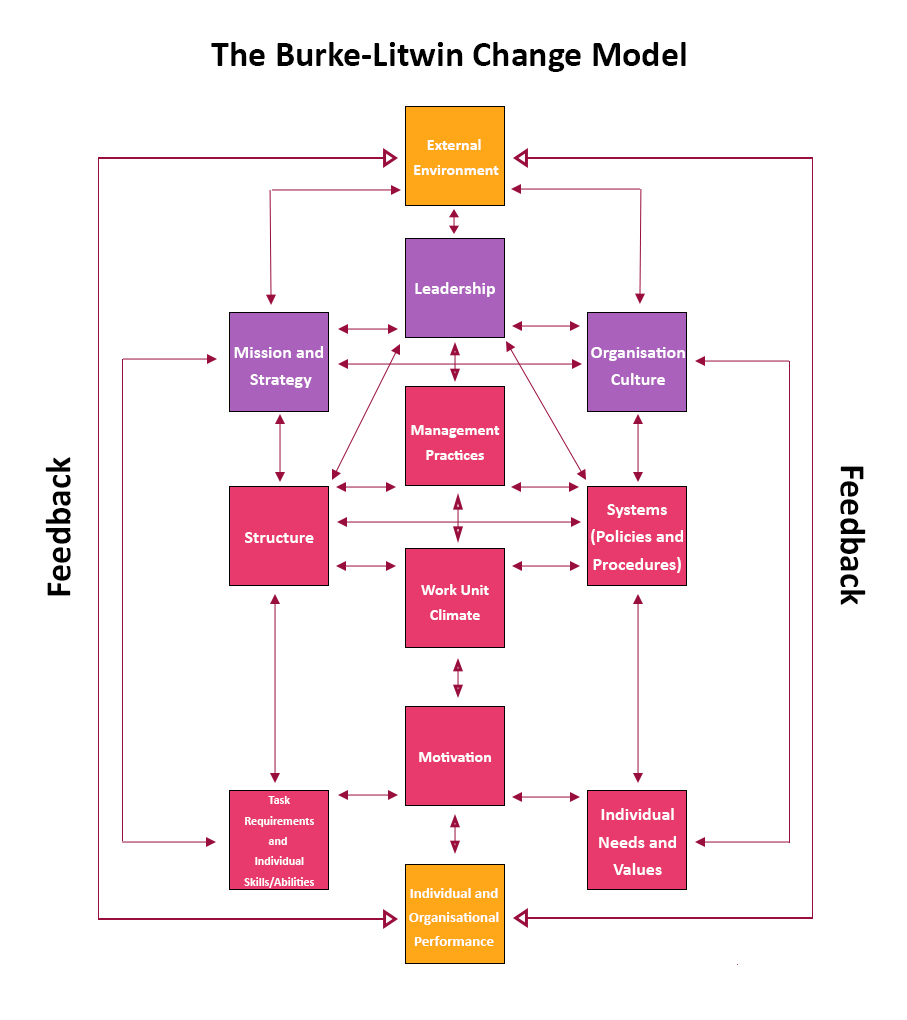12 Apr Burke-Litwin: The Performance and Change Model
The Performance and Change Model, developed in 1992 by two organisational change consultants, is a tool used to understand an organisation’s component parts and how they relate to each other in a time of change. A common reason for a change initiative failing is all areas of the organisation affected by the change are not accounted for. Therefore, using this model can reveal what areas of the business are affected and how they are interrelated. The model also demonstrates the hierarchy of factors within an organisation and hence the flow of influence from one factor to the next. The model is an example of ‘open systems theory’, which suggests change comes from external influences.
The authors describe the model as a mechanism that portrays “…the primary variables that need to be considered in any attempt to predict and explain the total behaviour output of an organisation, the most important interactions between these variables, and how they affect change”. There are four groups of elements within an organisation; the external environment, transformational factors, transactional factors and performance. Each group then contains various elements of the organisation. The diagram demonstrates which elements belong in which group, how they interact with each other and the overall hierarchy of an organisation.
The beginning and end of the process (yellow blocks) represent the input to the organisation, the external environment, and the organisation’s output, individual and organisational performance.
External Environment – This factor represents any forces or conditions outside of the organisation that will affect its processes. An example could be consumer behaviour or marketplace conditions.
Individual and Organisational Performance – This factor is the overall output of the organisation. This can be represented in many different ways, commonly turnover, productivity, customer satisfaction etc.
Transformational factors (purple blocks) are deeply embedded processes and characteristics of the organisation. Any change that occurs to these factors will have substantial consequences to the rest of the organisation. It is also true that any other change will require these factors’ input and hence the arrows go in both directions. Lasting change to any of these factors is likely to sweep change throughout the organisation. These factors will be most strongly affected by the external environment and will also have the strongest influence on transactional factors.
Leadership – The authors state this factor ‘provides direction’ to the rest of the organisation. Individuals in leadership positions are responsible for developing a vision and motivating the rest of the organisation to achieving it.
Mission and Strategy – This factor describes the purpose of the organisation and also the processes for how it will be achieved.
Organisation Culture – The norms and values of the organisation. They will be less formal than the ‘mission and strategy’, but will still exist implicitly throughout the organisation.
Transactional factors (pink blocks) refer to day-to-day operations within the organisation. The authors argue these factors are strongly affected by management, rather than leadership. Change in these factors is only likely to lead to lasting change if, in turn, the transformational factors are also affected.
Management Practices – Behaviours and activities of managers, usually aligned to carrying out the overall strategy.
Structure – The breakdown of the organisation i.e. hierarchy, departments, reporting channels.
Systems (Policies and Procedures) – These are the mechanisms put in place to help and support employees. This may be legal systems or reward systems, for example.
Work Unit Climate – The team’s working environment. For example, how well team members cooperate, how comfortable individuals feel expressing themselves or how well goals are set and rewarded.
Motivation – The setting of goals to inspire and direct employees.
Task Requirements and Individual Skills/Abilities – Matching the job description with the expertise of an employee. An experienced, high-level employee may still struggle to adopt new technologies, for example.
Individual Needs and Values – Employees will expect certain demands, such as pay, work/life balance, responsibility etc. to be met in their role.
The two main uses of the model are to either diagnose a problem within the organisation or create an action plan (often for a change initiative). Firstly, the group should be identified where either the change is coming from or being planned for. Then within that group the specific element should be identified. Once this has occurred, all affected elements can also be identified.
An example would be a change in legal working requirements (external environment). This would cause leadership to alter management practices, which in turn would affect the work unit climate and systems. Through motivation and individual needs and values, we would then see a change to individual and organisational performance.
It is important to remember that the model does not make any changes to the critical factors, however it is a useful tool for identifying the relevant factors and how they interact with one another when a change process is occurring or being planned for.
W W Burke & G H Litwin. (1992). A Causal Model of Organizational Performance and Change. Journal of Management. Vol 18. No 3 (1992) p 529.


